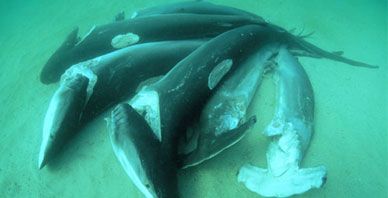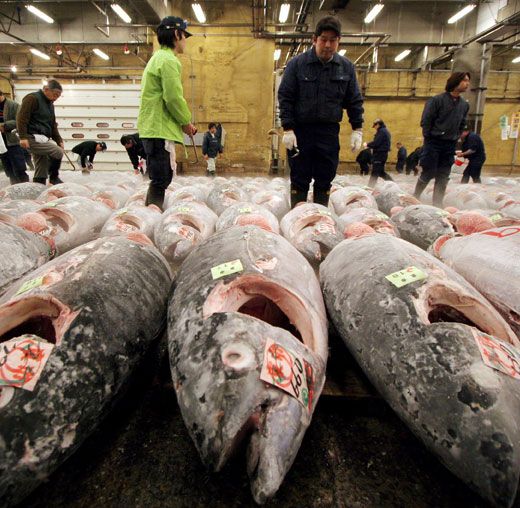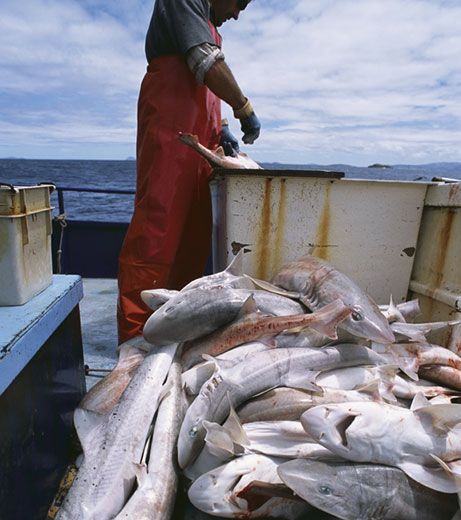Fishy Business
The problems with fishery management are mounting—and time may be running out
/https://tf-cmsv2-smithsonianmag-media.s3.amazonaws.com/filer/fishery631.jpg)
The United Nations Food and Agriculture Organization began collecting fishery statistics in the 1950s. About that time, industrial-scale fishing exploded; soon, more boats chased down more fish using more efficient equipment. Since then, 29 percent of commercial fish species have suffered collapses, and many more stocks have been depleted. Entire fishing industries, such as cod in Nova Scotia, have disappeared. Many fish species, like the bluefin tuna, are on the brink of extinction. Even birds and mammals that feed on fish, including humpback whales in Canada's Bay of Fundy, are losing the competition for fish to commercial fishing fleets.
Marine scientists agree that governments must act quickly to reverse the decline in fish stocks, but recent studies illustrate just how complex fishery problems have become. Multiple strategies are needed—and needed now—to ensure that ocean health is preserved, and to motivate the fishing industry to ply its trade in a sustainable manner.
"If [positive action] happens real fast, we can conceive of things being halfway sustained," says fisheries biologist Daniel Pauly of the University of British Columbia in Vancouver, Canada. "If this doesn't happen—and it looks unlikely—then the devastation will continue."
Over the years, management authorities have addressed the problem of overfishing in many ways, with limited success. They have put annual restrictions on total catch both at the fishery and vessel levels, ending seasons once the quotas are met. They have limited the availability of fishing licenses. They've even tried paying fishers to quit the business, through boat-buyback programs. But these efforts are undermined by government subsidies to the fishing industry, Pauly says.
In a non-subsidized world, once fish stocks become depleted, fishers would no longer be able to earn a living. They would, theoretically, migrate to other livelihoods, enabling the stocks to recuperate. Once replenished, the existing fisheries would prosper, competition would move in and this boom-and-bust cycle would repeat itself.
Subsidies short-circuit this system by paying fisheries to continue fishing depleted stocks, exacerbating the decline, impoverishing the ecosystem and contributing to the cycle of escalating subsidies. Roughly $30 billion in subsidies are paid each year—about one-third of the value of world fisheries, Pauly says.
In a review paper published in Science last June, a group of researchers led by fisheries expert John Beddington of Imperial College in London argues that subsidies undermine sustainability and should be replaced with rights-based incentives. Instead of relying on complex, top-down management, the authors suggest giving ownership rights to fishers under clearly stated rules. These include harvest strategies based on the size and health of fish stocks; catch restrictions based on the size and age of fish; gear restrictions; and well-defined fishing seasons and areas. The possibility of losing ownership rights, they argue, is enough incentive for fishers to comply with the responsible behavior.
In addition to adjusting practices, another important strategy is to adjust mindsets, says marine conservationist Boris Worm of Dalhousie University in Halifax, Canada. In the past, fisheries have sought to provide the maximum catch of fish that taste good while ignoring the larger effects this tactic has on the ocean. But now scientists believe that even individual marine species have a wide-reaching influence on the ocean ecosystem. Simply put, every species that is overfished threatens the sustainability of the sea.
This effect is especially clear along the East Coast of the United States. A study published in Science in March by Dalhousie scientist Ransom Myers shows that the impact of declining great shark populations is cascading through the marine ecosystem. Since 1972, growing demand for shark fins and meat has devastated shark populations by as much as 87 percent for sandbar sharks and 99 percent for bull, dusky and hammerhead sharks. As the sharks have declined, the populations of some of their prey, especially cownose rays, have exploded. In turn, more rays feed on more mollusks; in 2004, this biodiversity shift effectively put an end to North Carolina's 100-year-old scallop fishery and now threatens seagrass habitat along the coast.
"We're more cognizant of the fact that the ocean is not just a cheap machine that produces fish," Worm says. Instead, he says, it's a very intricate world that impacts habitat, marine mammals and birds, and that acts as an enormous filter to maintain water quality.
Because all life in the ocean is interconnected, figuring out how to manage it scientifically and institutionally has been a major challenge—one some have said is insurmountable. Worm, for one, thinks it's doable. "The idea isn't to manage the ecosystem; it's to manage and restrain our impact on it," he says. "We know how to do that, and we have, in fact, started to do it in many different places."
Designating marine protected areas (MPAs), like the 140,000 square-mile stretch of the Pacific northwest of Hawaii that was made a national monument in June of 2006, is one technique that governments are using to safeguard ocean diversity. Some parties resent the idea of completely excluding parts of the marine environment from fishing and other uses, yet most scientists see MPAs as essential. Much like national parks on land, these areas preserve regions of ocean biodiversity and allow them to exist in a natural state.
Right now, MPAs encompass less than 1 percent of the total ocean. In 2003, the 5th World Parks Conference set a target of protecting 20 to 30 percent of marine habitat. But getting consensus on what parts of the ocean to preserve is time-consuming, and governments are not creating MPAs fast enough, Pauly says. At the current rate, it will take roughly 70 years to reach the 20 percent target.
The only answer, Pauly says, is to act fast. Real fast. Governments and international agencies should accelerate the creation of MPAs, end all subsidies, implement tight control on what species can be fished and transfer oversight to those "who care and will exploit [the ocean] reasonably and sustainably and keep it safe from the trawlers of the world," he says.
According to Worm's models, published in 2006, people will run out of seafood by 2048 if current trends of overfishing and stock collapse continue. Yet he remains more optimistic about reversing the trend and restoring ocean biodiversity. Even though studies have shown that species bounce back in marine reserves, they're not a panacea, Worm says. They must be combined with measures to limit bycatch, implement sustainable fisheries practices and reduce pollution.
"I think we're starting to wrap our head around the fact that there's a lot of water out there, and that it's an essential ecosystem that's very important to the earth's life support system," Worm says. "We ought to take better care of it."
Anne Sasso is a freelance writer in New Jersey.
/https://tf-cmsv2-smithsonianmag-media.s3.amazonaws.com/accounts/headshot/eric-jaffe-240.jpg)



/https://tf-cmsv2-smithsonianmag-media.s3.amazonaws.com/accounts/headshot/eric-jaffe-240.jpg)